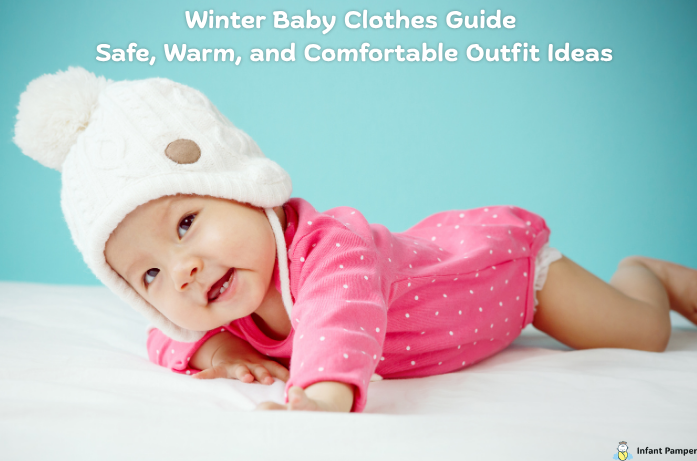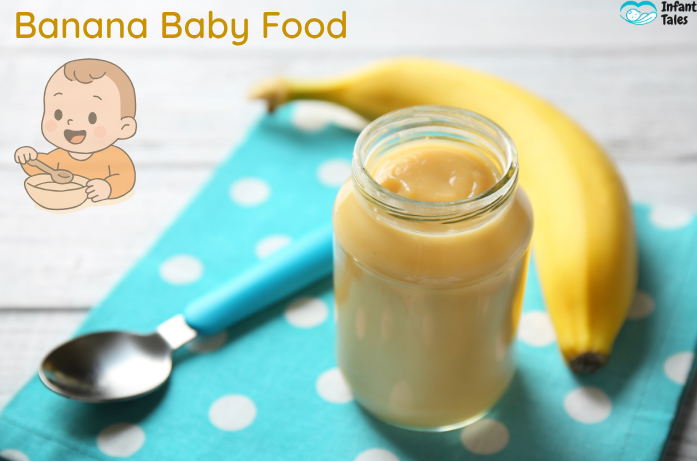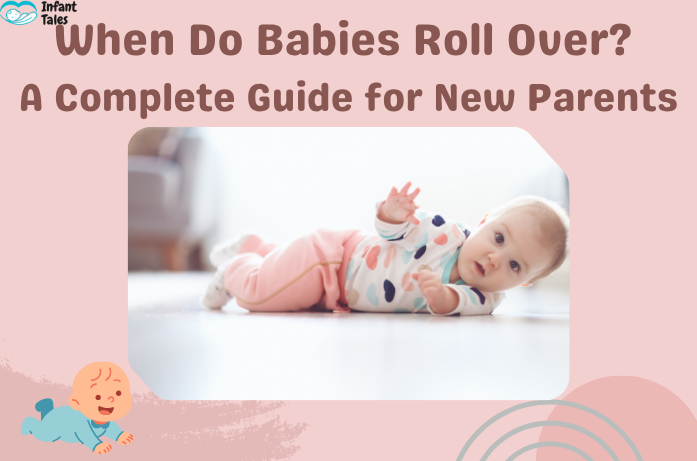By a Caring Mom at Infant Tales
Parents often ask themselves how to keep their baby warm, safe, and comfortable in winter, every time the temperatures start to drop and the daylight hours begin to dwindle. For new parents, choosing the right winter baby clothes can sometimes be difficult because they need to strike the right balance between warmth and ventilation. Babies are more susceptible to the cold than adults, and they can’t even verbally tell us when they’re feeling cold or too hot.
This comprehensive guide will help you understand everything about baby winter outfit ideas, from layering tips to the best clothing that will provide a comfortable, safe, and happy baby all season long.
Why Proper Winter Dressing Matters for Babies
Due to the fact that babies lose body heat much faster than adults due to their smaller size, and also their surface area-to-body ratio is higher, thus, choosing the right winter baby clothes is not only a fashion decision, but also a health and comfort issue for your baby.
New parents often make the mistake of overheating and over-bundling, resulting sometimes in rashes or waking up the baby. The American Academy of Pediatrics (AAP) says that infants should wear one extra layer than adults in the same environment.
Understanding Baby Layering: The Key to Comfort
The method to comfortable Winter Baby Clothes is layering. Correct layering allows moms and dads to put on or take off the child’s clothes according to temperature changes, thus, keeping the child warm but not sweaty.
Every parent can follow the simple layering guide below:
- Base Layer: A soft and breathable cotton bodysuit that wicks moisture is a must for the first layer.
- Middle Layer: For example, a sweater or thermal romper, add fleece or wool clothing of your choice to the child’s wardrobe for extra warmth.
- Outer Layer: In case you are going outdoors, pack a windproof snowsuit, jacket, or bunting bag for your baby.
When inside, take off the outer layer so that you do not sweat. A good winter baby dressing principle is to put your baby in one more layer than you would feel comfortable wearing yourself.
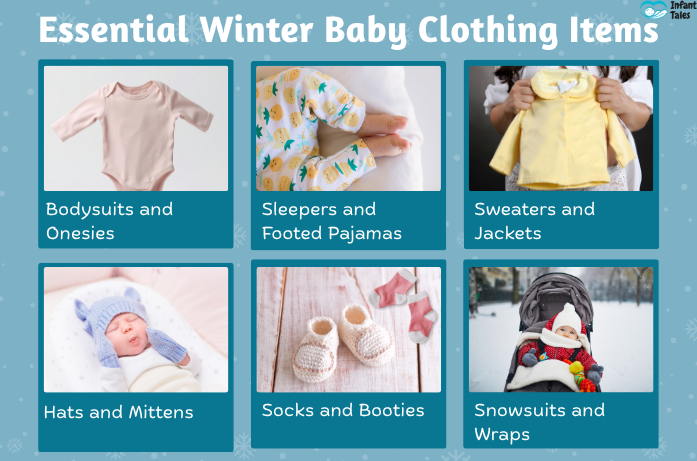
Essential Winter Baby Clothing Items
The process of accumulating your baby’s winter attire is not such a hard task. Every new parent should think about the following list of Winter Baby Clothes essentials:
- Bodysuits and Onesies: Opt for long-sleeve cotton onesies that keep the baby’s core warm without irritation.
- Sleepers and Footed Pajamas: Nighttime comfort and warmth, ideal. Buy those featuring built-in mittens.
- Sweaters and Jackets: Soft fleece or knit sweaters are perfect for layering. Stay away from rough wool that might irritate baby skin.
- Hats and Mittens: As babies lose most heat through their heads, always keep them covered when outside. You can explore our complete Baby Winter Hat Guide for Parents to learn about the best materials, perfect fit, and safety tips for keeping your little one’s head warm during cold weather.”
- Socks and Booties: Key are warm feet! Make sure that socks are snug but not tight.
- Snowsuits and Bunting Bags: Great for outdoor walking or stroller rides.
- Blankets and Wraps: When you want the baby to be warm try using these but be informed that no loose blankets in cribs are a safety measure.
Each item of Winter Baby Clothes should be soft, breathable, and safe for delicate skin. Always opt for flame-resistant fabrics and stay away from accessories with loose strings or small parts.
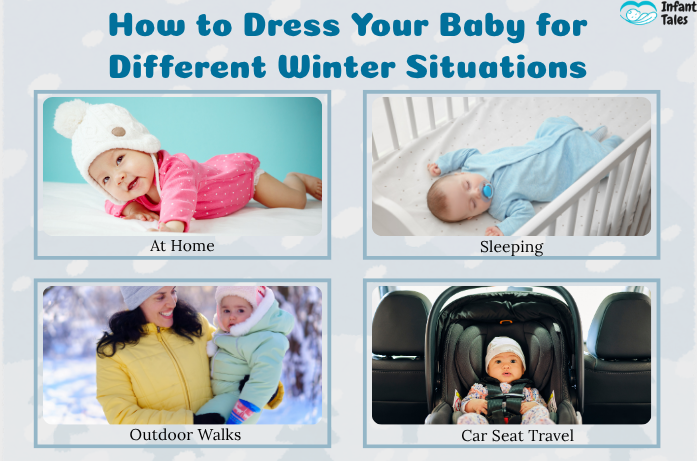
How to Dress Your Baby for Different Winter Situations
Different climates warrant different baby winter outfit ideas, and here are some methods to ensure your baby is always properly dressed:
- At Home: Go for light layering like a cotton bodysuit and a fleece sleepsuit. Indoor heating keeps the house warm enough so don’t overdress.
- Sleeping: A one-piece sleeper or a wearable blanket with the right TOG rating for your room temperature is the best choice. Avoid loose blankets to follow baby winter safety tips.
- Outdoor Walks: Put on your baby in layers like a bodysuit, a sweater, a snowsuit, a hat, mittens, and good warm socks. A stroller cover would be an excellent accessory for the wind.
- Car Seat Travel: Never put your baby in a car seat wearing a thick coat, place on thin clothing under the harness and use a thin blanket over the straps for warmth instead.
(These recommendations are all in line with NHTSA safety recommendations.) These will help make sure your Winter Baby Clothes fashion choices are both safe and cute!
Fabric Guide: What are the Best Fabrics for Winter Baby Clothes
I should also mention that when researching Winter Baby Clothes, the type of fabric is just as important as the number of layers you put on a baby. Soft breathable and moisture-wicking fabrics are best for baby’s sensitive skin.
Here’s a quick comparison:
- Cotton: Baby’s skin friendly, breathable, and base layers favorite.
- Fleece: Warm and lightened, perfect for outerwear and blankets.
- Wool: Good insulation from nature but may be scratchy; choose merino wool for comfort.
- Flannel: Soft and warm for wearing during sleep.
- Bamboo: Nature-friendly and non-allergenic for babies with sensitive skin.
Avoid 100% synthetic materials at all costs, as they may result in sweating or itching. It is advisable to wash Winter Baby Clothes using a mild, fragrance-free detergent to preserve their softness and prevent skin reactions.
Signs Your Baby Is Too Hot or Too Cold
Parents frequently have a hard time deciding whether their Winter Baby Clothes options are correct. The simplest way to find out is to touch the baby’s chest, neck, or back, as these areas show core temperature better than hands or feet.
Signs your baby is too cold: cold chest, skin turning white, shivering.
Signs your baby is too hot: red face, dripping sweat, breathing rapidly, wet hair.
If you observe any of these, change the layers up or down. Applying these baby winter safety tips lets your baby keep warm yet never hot.
Eco-Friendly and Sustainable Winter Clothing Tips
Sustainable and skin-safe Winter Baby Clothes are among the top priorities for many parents. Excellent choices are organic cotton, bamboo blends, and responsibly sourced wool.
These materials not only cater to sensitive skin but also promote waste reduction. The selection of eco-friendly baby winter outfit ideas is a caring gesture towards both your child and the earth.
Common Mistakes Parents Make When Dressing Babies in Winter
Winter Baby Clothes can sometimes be the cause of small mistakes by parents with the best of intentions. The following is a list of mistakes to steer clear of:
- Over-bundling indoors: This can lead to overheating.
- Using loose blankets in cribs: This increases the risk of suffocation.
- Layering thick coats in car seats: This is not safe for snugness of harness.
- Disregarding any temperature cues: Babies cannot regulate heat like a human being.
These corrections will help to ensure that your routine for baby winter safety tips is working effectively and safely.
Quick Winter Dressing Checklist for Parents
Before you leave the house, skim through this quick checklist for your routine for baby winter clothes:
- Check the temperature of the room. Then add one layer based on that.
- Make sure baby’s head, hands, and feet are warm
- Before putting baby in car seat, remove any big layers.
- Bring an extra blanket for everything outside.
- Use your judgement and check baby’s comfort level.
This checklist is a great means of support for you to feel confident in determining how to dress baby in the winter every day.
FAQs: Winter Baby Clothes & Safety
1. How many layers should a baby wear in winter?
Generally, one more layer than an adult would wear in the same temperature.
2. Is fleece safe for newborns?
Yes, fleece is very light and warm, hence, it is suitable for the outer layers in Winter Baby Clothes.
3. What should a baby wear to sleep in winter?
A cotton or fleece sleepsuit with a wearable blanket. No loose covers.
4. Is it okay to put a blanket in the crib?
No, it is not safe. Cover your baby with a sleep sack or use a swaddle.
5. What can be the signs for me to know that my baby is cold during the night?
Feel their chest or neck; it should be warm, not cold or sweaty.
Conclusion: Keeping Warm, Safe, and Happy
Dressing your little one in winter clothes doesn’t have to be a big deal. With the right winter baby clothes for the weather, along with the right layering and fabrics for your baby, you can keep them comfortable, safe, and happy all winter long.
Winter brings nothing but cuddles, warmth, and the chance to create family memories, and with these baby winter outfits, your little one will be in the middle of it all, enjoying every moment with comfort and care.
For more parenting tips, baby care guides, and seasonal advice, visit Infant Tales.
Disclaimer: This article is purely informative and is not a substitute for professional medical advice. Always consult your pediatrician for the guidance of your baby’s health and temperature safety.
